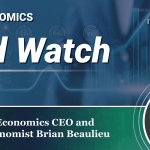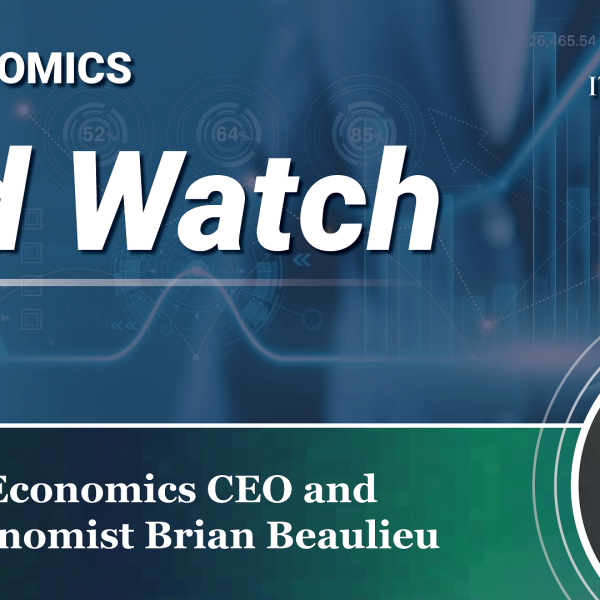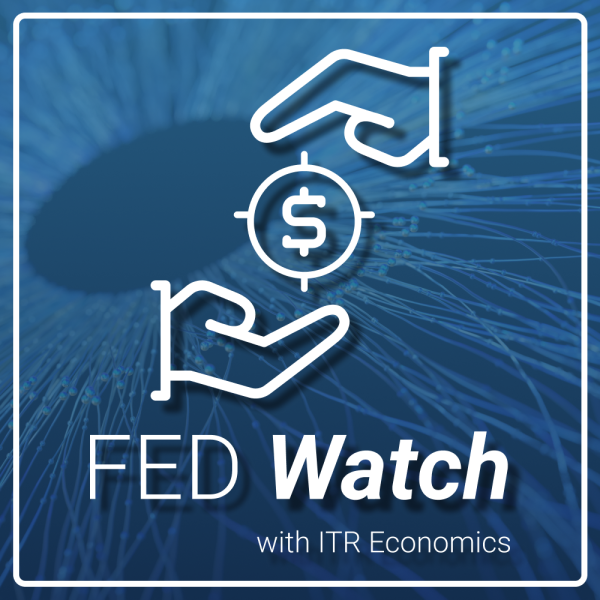- Mon - Fri: 8:30 - 5:00
- +1-603-796-2500
- ITR@itreconomics.com
with Brian Beaulieu
WEEKLY FED WATCH
Join us this week on Fed Watch as ITR Economics Chief Economist Brian Beaulieu discusses all the news from the Federal Reserve’s latest meeting and highlights the strength of the US dollar, consumer expectations, and wage trends.
Key Episode Takeaways
- 0:19 – Federal Reserve Board did not change interest rates
- 0:53 – The Fed is going to taper back on quantitative tightening
- 1:22 – The Fed is taking things slow
- 2:06 – It is likely the US dollar will be staying strong through 2024 and ‘25
- 3:17 – The economic slowdown has not been altering employment trends
- 4:39 – Wages remain the biggest hang-up to getting the CPI and PCE Price Index down
- 4:50 – Summary and conclusion
The below transcript is a literal translation of the podcast audio that has been machine generated by Rev.
Hello, I am Brian Beaulieu from ITR Economics, today is May 3rd, 2024, and welcome to this edition of Fed Watch. Federal Reserve had a meeting this Wednesday, and no surprise, of late anyways, they decided not to raise or lower interest rates. They just left them where they were. And going back almost a year now, it’s a bit of a disappointment. We had originally thought that they perhaps could be, as early as May, lowering interest rates, and that’s obviously been pushed off as CPI and the PCE price deflator are stubborn coming down. We’ll get into that in just a moment. But out of Wednesday’s meeting, there was another piece of really interesting news that I’m not sure everybody picked up on, and that’s Powell was saying that the Fed is going to taper back on their quantitative tightening. And what that means is instead of effectively sterilizing 60 billion dollars a month of liquidity out of the economy, they’re cutting that back to 25 billion. So they’re going to be taking less liquidity out of the economy.
And I don’t blame them for going slow on this. The last time they made a quick move, there was some very unpleasant unintended consequences on the repo market. So they’re just taking it slow. Some folks are thinking that just the tapering off of QT is going to be enough to get interest rates lower. I’m not so sure. With the economy holding up as well as it is and wages continuing to go up, I think maybe we’ll see a little less pressure on these interest rates and able to see some decline perhaps going on. But I really would hope that they’d go into a neutral position. Then we’ll have our best chance of seeing some long-term interest rates come down.
I did some analysis this week and fairly convinced that the US is outside of Argentina’s of the world and such things. Of the major industrialized partners that we have, we’re likely to run the highest inflation rate of those trading partners going through 2024 and likely 2025. And the implication of that is that generally means that the US dollar will be staying on the strong side through the remainder of this year and 25, in case that impacts any of your thinking or your exchange rate hedging. Switching over to some data that came out, it really continues to be the tale of two cities. We look at consumer expectations, which is not one that we generally follow at ITR, but it tends to be handy when it comes to the automotive industry, for instance, and the most recent conference board consumer expectations number was not good. It was showing some decided weakness, particularly in the rates of change, and that suggests ongoing weakness in that automotive sector.
Manufacturing new orders, 1/12 went back into phase D, non-defense capital goods, new orders, a broader segment also, sorry, it’s 1/12, go back down below the zero line. So we’re seeing that ongoing weakness poking up here and there. But you go on the other side of it and the job support that came out today, private sector employment, showed only marginally slower growth. So we’re getting this drag on the economy in the first quarter, and really through April by the sounds of things, yet the employment numbers are really… You have to go out two significant digits to the right of the decimal point before you can measure any slowdown going on in that growth rate.
And that’s part of the tale of two cities. We have a slowdown going on, but we’re not seeing it really alter the employment trend. And I think worse yet in terms of seeing interest rate decline, if that’s what you were hoping for, is that manufacturing employment remains uncharacteristically high in terms of the rate of rise in manufacturing. Wages and construction wages are clearly in an unusual cycle right now. A lot of that no doubt having to do with all the stimulus programs that came out of Washington.
As we have talked about before, it’s wages that are the biggest hang up to getting the CPI and the PCE price index down, and we’re not seeing any significant relief just yet. Those two series I mentioned, manufacturing and construction, both have tentative reversals in the 3/12 rate of change, but at elevated levels. So there’s no immediate relief. Chairman Powell, and I hope he is right, he said that he still thinks there’s a way to see the CPI get into some sustained decline, PCE get into some sustainable decline to the extent that he was still saying he sees interest rate decline in the second half of this year, potentially three different cuts. Just to remind you though, that looks like now the most we would expect would be 75 bips, and that’s not enough to significantly alter the landscape. Maybe some expectations, maybe get some first-time homebuyers into the market, move some people out of their current homes, but it’s not going to be a sea change in the financial scene. That’s where we stand today. We’ll see you next week. Thanks for watching this edition of Fed Watch.




